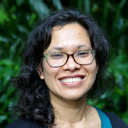
From the recent toolboxes and manuals developed by CIFOR, the World Agroforestry Centre (ICRAF) and CCAFS, as well as the many research and development initiatives already under way, participatory gender research was on the rise in 2014.
One can look no further than December’s Global Landscapes Forum in Lima, where thematic pavilions aimed at knowledge-sharing included a Gender Pavilion hosted by CIFOR in partnership with CIAT, ICIMOD, IUCN, GGCA, RECOFTC and REFACOF.
Informed by a well-rounded group of research, development and advocacy organizations, the Gender Pavilion focused specifically on participatory approaches to gender research. Participatory approaches differ from traditional research methodology in both ideological and practical terms. As a rule, women and men—for whom the project is anticipated to have differentiated impacts—should be empowered to meaningfully participate in the project, starting from target and priority settings.
Participatory approaches introduce a bottom-up view toward research and development, as the informed consent of those impacted is essential. Information is ideally not only extracted from participants, but also produced in cooperation with them. Participatory methods are thus designed to allow for these objectives to be met.
One initiative showcased at the Gender Pavilion was CIAT’s ongoing participatory photography project. In her presentation, Manon Koningstein, Research Officer at CIAT, explained that the project is based on the idea that the use of videography and photography can make participatory research even more inclusive.
“There is no need to be literate; men and women can participate in an equal way,” Koningstein said. “By showcasing their voices, we as researchers are able to understand local needs and can use this in our research strategies and recommendations to be able to adequately adapt them to these local needs.”
PARTICIPATION AND PERSPECTIVES
The “whys” and “hows” of participatory gender research received further attention in a group discussion during the Forum’s Knowledge Share-Fair. During the discussion, Tatiana Gumucio, a visiting researcher at CIAT, commended participatory approaches for their ability to capture perspectives that “can sometimes get overlooked or that aren’t able to get captured through other research design/frameworks.”
Jennifer Twyman, CIAT’s newly appointed Gender Coordinator, added that, especially when coupled with quantitative methods, participatory gender research can “help identify problems, guide the design and development … [and] aid in interpreting results from quantitative studies.”
Bimbika Sijapati Basnett, Scientist and Gender Coordinator at CIFOR, raised another dimension: “[P]articipatory research is one way in which research organizations can do research while simultaneously doing capacity building and outreach.”
CIFOR’s ongoing research project on gender-equitable rights and access to forest and tree resources and benefits, led by Esther Mwangi and Anne Larson, has paired research with action. The project uses a methodology known as Adaptive Collaborative Management to collect data for research—an approach that has also contributed to women’s increased participation in decision-making, as well as more tolerant attitudes from men towards women’s leadership in study sites.
Non-research organizations also acknowledge the benefits of participatory research. RECOFTC, for example, reported that it often uses participatory research to continue building evidence to inform its advocacy work.
AMONG THE CHALLENGES: TIME
As with all research methods, participatory approaches come with challenges, and should be employed with caution. As Twyman warned, participatory methods are clearly beneficial but often time-consuming, both for researchers and community members.
“Community members are busy people, and sometimes adding to their time burden does not make sense,” Twyman said. “We as researchers need to consider the costs and benefits of interacting with people and understand how to most efficiently use their time.”
Chandra Silori, REDD+ Coordinator at RECOFTC, noted the importance of cultural sensitivity: “For me the first and foremost challenge is to understand the basic concept of gender, gender mainstreaming, gender equity, equality. Also, these terms need to be understood in local cultural context.”
Chanda Gurung Goodrich, Senior Gender Specialist at ICIMOD, cautioned against adopting a crude, binary analysis in gender research, which she said often “focuses on highlighting differences between men and women, and forgets to highlight those within the categories of ‘men’ and ‘women’.”
Designing projects methodologically to ensure that all voices are heard, the experts noted, is therefore essential for detecting and analyzing more complex and socially differentiated aspects of power.
THE SCIENTIST-PARTICIPANT RELATIONSHIP
Other crucial considerations are the timing, location and design of research in order to ensure women’s participation in research projects. Margaux Granat, Policy Specialist at IUCN, mentioned women’s domestic responsibilities, such as child care and cooking, as examples of issues that might restrict women’s participation in projects located far from their homes.
The group discussion at the Gender Pavilion also touched upon more deep-rooted challenges, such as potential biases stemming from local power dynamics, and the relationship between the researcher and the researched.
Of course, although these are important and challenging issues for every participatory initiative, Basnett also warned the group against overemphasizing biases and thus delegitimizing participatory research.
“Feminists have written quite a bit about ‘biases’ and the ways in which researcher, researched and the production of knowledge from the interactions between the two are fundamentally biased regardless of the type of methods being used—whether household surveys or other methodologies,” Basnett said. “We need to be aware of these issues rather than delegitimizing one type of knowledge generation as being more biased than another.”
Editor’s Note: Tatiana Gumicio, Manon Koningstein and Jennifer Twyman of CIAT; Chanda Gurung Goodrich of ICIMOD; Margaux Granat of IUCN; and Chandra Silori of RECOFTC contributed to this article.
Markus Ihalainen may be reached at m.ihalainen@cgiar.org; Bimbika Sijapati Basnett may be reached at b.basnett@cgiar.org.
CIFOR’s research on gender forms part of the CGIAR Research Program on Forests, Trees and Agroforestry.
We want you to share Forests News content, which is licensed under Creative Commons Attribution-NonCommercial-ShareAlike 4.0 International (CC BY-NC-SA 4.0). This means you are free to redistribute our material for non-commercial purposes. All we ask is that you give Forests News appropriate credit and link to the original Forests News content, indicate if changes were made, and distribute your contributions under the same Creative Commons license. You must notify Forests News if you repost, reprint or reuse our materials by contacting forestsnews@cifor-icraf.org.















